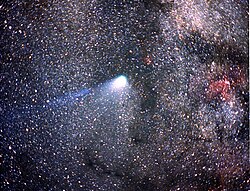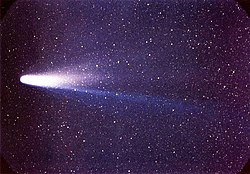Halley's Comet
Halley's Comet (Comet Halley) is a comet which comes round every 75 or 76 years. When it is near, it can be seen with the naked eye. It will return in 2061.
The comet is named after Edmond Halley (1656–1742), an English astronomer, who predicted the comet's return. Halley's Comet was the first comet to be recognized as periodic. (Periodic means that it comes by Earth regularly.)
When the comet came close to the Earth in 1986, it was visited by several space-probes. The probe Giotto from the European Space Agency managed the closest approach to the comet.
The number of years that the comet finishes its full cycle can vary depending on the effect of another planet's gravitational pull.
In 1986, Halley's Comet was the first to be observed in detail by spacecraft. It gave the first data on the structure of a comet nucleus and how the coma (nebulous envelope around the core or nucleus) and the tail formed.[1][2] These observations supported Fred Whipple's "dirty snowball" model. This correctly predicted that Halley would be composed of a mixture of volatile ices – such as water, carbon dioxide, ammonia, – and dust. The missions also adjusted these ideas. For example, it is now known that the surface of Halley is mostly dusty, non-volatile materials, and that only a small portion of it is icy.
Coming closer to the Sun again: Since 2023, it is closing the distance between the Sun and itself.
Halley's Comet Media
Jamaican polymath Francis Williams (portrait attributed to William Williams, c. 1760). The only contemporary illustration of an astronomer detecting the comet's return.
Halley's Comet in 1066 depicted on the Bayeux Tapestry
The Adoration of the Magi (circa 1305) by Giotto, who purportedly modelled the star of Bethlehem on Halley, which had been sighted 4 years before that painting.
Illustration of the 1531 appearance in Petrus Apianus' Astronomicum Caesareum, noting that a comet's tail always points away from the sun
Related pages
References
- ↑ Mendis D.A. 1988. A postencounter view of comets. Annual Review of Astronomy and Astrophysics 26 (1): 11–49. [1][dead link]
- ↑ Keller H.U. et al 2005. In situ observations of cometary nuclei. In M. Festou, H.U. Keller, and H.A. Weaver (eds). Comets II. University of Arizona Press. pp. 211–222. [2] ISBN 978-0-8165-2450-1








